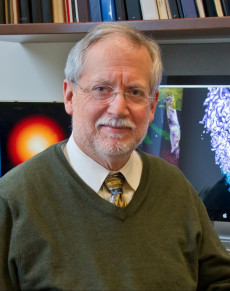David Brown to Step Down as AMCR Division Director in Early 2022
November 10, 2021
By Linda Vu
Contact: cscomms@lbl.gov
David Brown, who has served as the research division director in Berkeley Lab’s Computing Sciences Area (CSA) for more than a decade, will step down in early 2022. Associate Laboratory Director Jonathan Carter will be forming a search committee for Brown’s replacement in the next few weeks.
“After more than 37 years with the Department of Energy (DOE) National Laboratory system, I can say without a doubt that all of the national laboratories I’ve been associated with have been fantastic — but my time at Berkeley Lab has been the real highlight of my scientific career,” said Brown.
“I deeply appreciate having had David as a colleague for these past 10 years,” said Carter. “His leadership of the division, his focus on building new partnerships both internal and external to the lab, and his initiating a broad engagement in diversity, equity, and inclusion have been central to our many successes. I wish David the very best for the future and thank him for all his contributions to the Computing Sciences Area.”
“By promoting our strengths in applied mathematics, computer science, and data science research, David has played a central role in positioning Berkeley Lab among the premier institutions for computational research," said Berkeley Lab Director Mike Witherell. "His leadership has led to highly productive collaborations across our Lab’s scientific divisions, many other DOE national laboratories, several federal agencies, and private institutions. I thank David for his dedication and service to Berkeley Lab, and wish him all the best in his future endeavors.”
Since Brown took the helm of Berkeley Lab’s Computational Research Division (CRD) in 2011, he’s overseen two reorganizations. His first reorganization in 2014 created four new departments within CRD to highlight the Laboratory’s strengths in applied mathematics, computer science, data science, and technology research.
At the time, Brown emphasized the rapidly growing trend toward interdisciplinary research and the importance of effective collaboration across CRD, Berkeley Lab, and beyond. He also cited the increasing importance of data-intensive science at Berkeley Lab and within DOE, as a reason for establishing a Data Science and Technology Department within CRD.
In seven years, the Data Science and Technology Department grew significantly. Its researchers became leaders in aspects of data science like scientific data management, machine learning, and science user-centric design; and built partnerships in every scientific area at Berkeley Lab. A new Scientific Data Division was created last month to position Berkeley Lab among the preeminent institutions for data science research.
“In 2011, the application of mathematics and computing to managing and understanding experimental data represented only a small part of our activities; it now represents at least half of our research effort in computing and we have recently spun off the Scientific Data Division, an exciting new scientific division for Berkeley Lab,” said Brown. “At the same time, our historic strengths in computational modeling and simulation have only expanded and improved; this is evident in Berkeley Lab’s responsibility for the largest application development portfolio in the DOE Exascale Computing Project by far.”
In addition to Brown’s organizational contributions, he also took a leading role in developing the Sustainable Research Pathways (SRP) program, which allows visiting faculty and their students to engage in Berkeley Lab’s innovative research environment. Since its launch in 2015, more than 400 faculty and students from predominantly minority-serving academic institutions and women’s, liberal arts, community, and other small colleges have attended the annual SRP workshop to learn about the Berkeley Lab’s research environment and find research opportunities for themselves and their students.
After participating in SRP, student participants said they experienced “life-changing” effects, developed an increased sense of confidence in their scientific futures, and changed their plans in favor of more research-intensive academic and career pathways. Brown and his collaborator Mary Ann Leung, Founder and President of the Sustainable Horizons Institute, were recognized by Berkeley Lab’s Workforce Development & Education (WD&E) for their mentorship contributions in 2019.
“It has truly been both an honor and pleasure to represent some of the finest and most talented researchers in the DOE complex and to be supported by a creative and enthusiastic administrative team. I have no doubt that the opportunity to lead such an incredible group will attract some of the best talents in the community,” he added.
About Berkeley Lab
Founded in 1931 on the belief that the biggest scientific challenges are best addressed by teams, Lawrence Berkeley National Laboratory and its scientists have been recognized with 16 Nobel Prizes. Today, Berkeley Lab researchers develop sustainable energy and environmental solutions, create useful new materials, advance the frontiers of computing, and probe the mysteries of life, matter, and the universe. Scientists from around the world rely on the Lab’s facilities for their own discovery science. Berkeley Lab is a multiprogram national laboratory, managed by the University of California for the U.S. Department of Energy’s Office of Science.
DOE’s Office of Science is the single largest supporter of basic research in the physical sciences in the United States, and is working to address some of the most pressing challenges of our time. For more information, please visit energy.gov/science.










